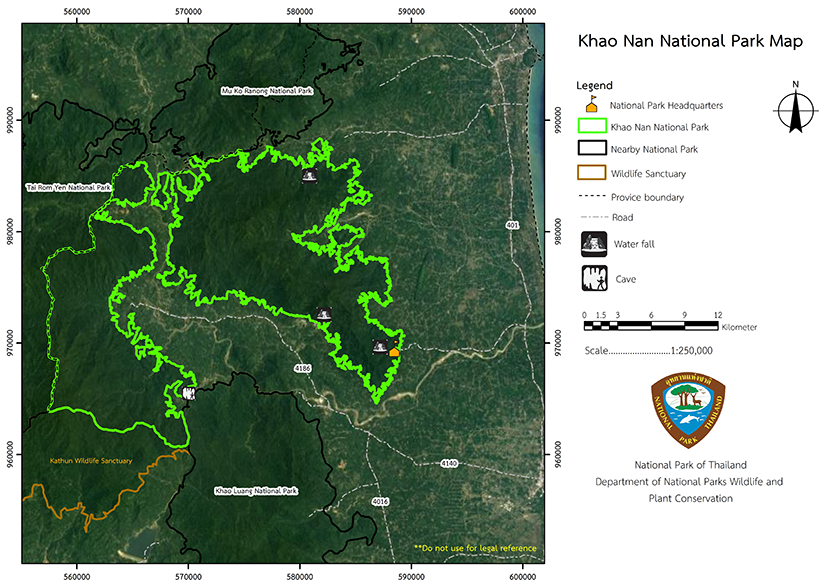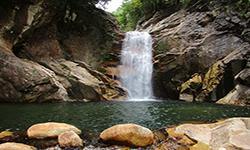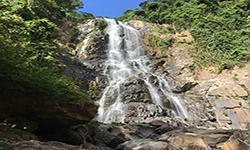Khao Nan National Park
Contact Location : Khao Nan National Park is located at Su Nantha Waterfall, Ban Pak Chao, Moo 8, Taling Chan Sub-district, Tha Sala District, Nakhon Si Thammarat Province, 80160.
Telephone Number : (+66) 7 580 9176 Fax: (+66) 7 580 9176
Email : k_haonan@hotmail.com
Facebook : Khao Nan National Park
Information
Khao Nan National Park covers Nopphitam and Krung Ching Sub-district, Nopphitam District, Taling Chan Sub-district, Tha Sala District, and Khao Noi, Plian, Chalong and Thepparat Sub-district, Sichon District in Nakhon Si Thammarat Province. It has an area of approximately 410 square kilometers, or 256,121 rai.
The boundaries are as follows:
North: Namtok Si Khit National Park
East: An agricultural area of the village
West: Tai Rom Yen National Park
South: Kathun Wildlife Sanctuary and Khao Luang National Park
Background
In 1988, a great flood in the southern region caused the loss of life and property in the Kratoon House area of Phipun District, Nakhon Si Thammarat Province. Following those tragic events, the Royal Forest Department surveyed the area to consider establishing a national park in order to reduce the chances of it happening again. The preliminary survey shows that the site consists of Krung Ching National Reserved Forest, Khao Nan Forest, and Khlong Pian Forest, adjacent to Khao Luang National Park and Tai Rom Yen National Park. Therefore, Mr. Luesak Sakphan, Forest Officer 4, National Park Division, was ordered to conduct a further survey that found the forest invasion and logging had occurred, and at that timehuman resources and budget were insufficient for the prevention and suppression of these activities, which had led to the flooding.
Later in 2004, a survey was carried out to mark the boundary line until it was completed, and the Bureau of Rehabilitation submitted the defined area to the draft royal decree, and it was sent to the Office of National Parks in 2007 after correction. Consequently, there was an announcement of the establishment of Khao Nan National Park by royal decree in the Government Gazette dated December 23, 2009, effective from December 24, 2009, and it became Thailand’s 113th National Park.
Note : After paying the entrance fee to the National Park, please carry the receipt for inspection.

256,121 rai (409.7936 square kilometers)
|
|
|
|
|
|
|
|
Nature trails ⇔ Trekking ⇔ Visit Waterfall ⇔ Viewpoint ⇔ Cave exploration/Geological condition ⇔ Observe flowers/plant ⇔ Bird/Butterfly ⇔ Wildlife watching activities ⇔ Stargazing ⇔ Mountain biking ⇔ Camping
Welfare shop : Not available.
Khao Nan National Park office area: AIS, TRUE, DTAC
Sunantha Waterfall area: AIS, TRUE, DTAC, but not stable.
Khlong Yot Nam Waterfall area: AIS
Hong Cave area: AIS, TRUE
|
|
The terrain is a complex high mountain range on a north south axis. It includes Khao Nan Yai Peak, Nanmia Mountain, Lek Mountain, Chong Lom Mountain, Dai Mountain, Khao Khom, Khao He Li Yom with the highest peak being Khao Nan Yai at approximately 1,438 meters above sea level. It is the third-highest in the Nakhon Si Thammarat Mountain range. Generally, the forest is a fertile, moist evergreen forest with a cloud forest ecosystem that covers the forest area. Mosses, ferns, orchids, and epiphytic plants can grow densely. It is also a vital catchment area, along with a habitat for many kinds of animals. Abundant wildlife and plant species are found in the area, and it is also rich in minerals such as tin, barite, and wolfram. A waterfall that still maintains its natural beauty is an essential attraction of Khao Nan National Park. Soil Characteristics Khao Nan National Park’s topography is mainly mountainous with slopes of more than 3%. The characteristics and properties of the soil are uncertain but there is both deep and shallow soil. The nature of the soil texture and natural fertility vary depending on the type of rock origin, and scattered stones and outcrops are often found in the area. Different types of forests cover the area including mixed deciduous forest, deciduous dipterocarp forest or tropical rain forest. The soils have good drainage but poor fertility, and are made up of loam, sandy loam, or clay texture, which is typical soil in most areas, or about 95% of the National Park. Water resources and quality classification of watersheds The main watersheds of Khao Nan National Park are on the east coast and the southern watershed located in the Khlong Klai Basin. The category of watershed quality in Khao Nan National Park primarily consists of basin 1A at 77.12%, followed by the watershed of the National Park area at 16.06%. The characteristics of canals around Khao Nan National Park are that they are long and flows from west to east. They consist of Klai Canal, Phot Canal, Long Canal, Chik Creek, Sian Canal, Pian Canal, Krung Nang Creek, Phong Creek, Chae Canal, Lek Creek, and Phi Tam Canal, flowing into Klai Canal in the southeast of the area. Tha Thon Canal, Phian Canal, Sam Thep Canal, |
|
The climate is primarily all year round rain. The rainy season starts in May and increases in rainfall from October to December, after which the rain decreases in January. Summer starts from February to April, but it still rains sometimes because of the high humidity. Climate
|
|
|
|
Common Plants includeMalacca Teak (Intsia Palembanica), Hopea odorata (Hopea odorata), Parashorea stellata Kurz (Parashorea stellata), Shorea gratissima (Shorea gratissima), Shorea ferinosa (Shorea ferinosa), Mesawa (Anisoptera coatapa), Cinnamomum parthenoxylon (Jack) Meisn. (Cinnanomum porrectunum), Eugenia 147onjugate147 (Eugenia 147onjugate147), Hertiera sumatrana (Hertiera sumatrana), Michelia champaca (Michelia champaca), Ailanthus triphysa (Ailanthus triphysa), Toona tebrifuga (Toona tebrifuga), Parkia speciosa Hassk. (Parkia speciosa), Elateriospermum tapos Bl. (Elateriospermum tapos), Xerospermum intermedium (Xmederospermum) Wild animals found are divided into five types as follows: Mammals: There are more than 59 species including Serows ( Capricornis sumatraensis) , Malayan Tapir (Tapirus indicus) , Elephans maximus, Wild Boar (Sus scrofa) , Sambar Deer ( Cervus unicolor) , Javan Mongoose ( H. all Javanicus) , Common Palm Civet (Paradoxurus hermaphroditus) , Binturong ( Arctictis binturong) , Giant Gourami (Hystria brachyura) , Black Flying Squirrel ( Aeromys stephromelas) , Black Giant Squirrel (Ratufa bicolor) , White Handed Gibbon (Hylobates lar), Sunda Flying Lemur (Cynocephalus variegates), Common Treeshrew (Tupaia glis), and Asian Golden Cat (Catopuma temminckii) 2. Birds:There are more than 56 species including the Great Argus (Argusianus argus), Malayan Peacock-Pheasant (Polyplectron malaceuse), Great Hornbill (Buceros bicornis), Red Junglefowl (Gallus gallus) , Thick- billed Green Pigeon (Treron curvirostra) , Grey- Capped Emerald Dove (Chalcophaps indica), Greater Coucal (Centropus sinensis), Collared Scops Owl (Otus lempiji), Short-Eared Owl (Otus sunia) , White-Throated Kingfisher (Haley smymensis) , Blue-Throated Barbet (Megalaima incognita) , Black- Headed Bulbul (Pycnonotus atriceps) , Black- Crested Bulbul (P. Melanicterus), Spectacled Bulbul (P. Erythropthalmus) Greater Racket-Tailed Drongo ( Dicrurus Paradisseus) , Asian Fairy Bluebird ( Irena Puella) , Jungle Crow ( Corvus macrorhynchos), White-Rumped Shama (Copsychus Malabaricus), Chestnut-Headed Bee-Eater (Merops 148onjugate148e148a) , Crested Serpent-Eagle (Spilornis cheela) ) , Green-Tailed Sunbird (Aethopyga nipalensis australis) 3. Reptiles: There are more than 22 species including The Malayan Softshell Turtle (Trionyx subplanus), Orange-Headed Temple Terrapin (Heosemys grandis), Bengal Monitor(V. bengalensis), Common Water Monitor (V. Salvator), Flying Dragon (Draco spp.), Many-Lined Sun Skink (Mabuya multifasciata), Python curtus, Asian Vine Snake (Ahaetulla prasina), King Cobra (Ophiophajus hammah), Cobra (Naja) 5. Fish: There are more than 7 species of fish including the Slender Walking Catfish (Prophagours cataractgus), Mahseer Barb (Tor soro), Danio aequipinnatus (Danio aequipinnatus), Minnow (Danio Regina), Long Barbel Danio (Danio peninsulas), Mastacembelidae (Mastacembelus armatus), and T-Barb (Puntius lateristriga) |
How to get there by car :
From Bangkok to Surat Thani, then take Highway No.401 through Kan Chon Dit District, Donsak District, and Nakhon Si Thammarat Province, passing through Khanom District, Sichon District, to Ban Klai intersection, and Tha Sala District. At the milestone No. 110 turn right towards Pakjao House, which is a distance of 15 kilometers from Khao Nan National Park Headquarters. It is a total distance of 744 kilometers
- National Park Ranger Station Kho No No. 1 (Khlong Klai)
- National Park Ranger Station Kho No No. 2 (Huai Kaeo)
- National Park Ranger Station Kho No No. 3 (Khlong Kan)
- National Park Ranger Station Kho No No. 4 (Khlong Tha Thon)
- National Park Ranger Station Kho No No. 5 (Huai Lek)
- National Park Ranger Station Kho No No. 6 (Khlong Lam Phaen)
- National Park Ranger Station Kho No No. 7 (Khlong Yotnam)
Khao Nan National Park does not have houses for visitors. However, there arecamping grounds where you can rent tents and equipment. Visitors are encouraged to bring their own tents and food, food is available at the shops and restaurants in front of the national park.




